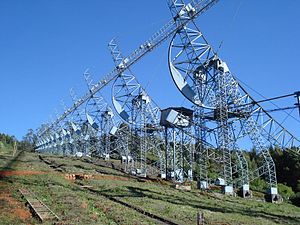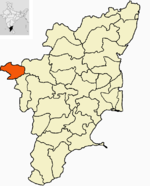- Ooty Radio Telescope
-
Ooty Radio Telescope  Radio Telescope at Ooty
Radio Telescope at OotyOrganization Tata Institute of Fundamental Research Location Muthorai, near Ooty, Tamil Nadu, India Coordinates 11°23′00″N 76°39′58″E / 11.383404°N 76.66616°ECoordinates: 11°23′00″N 76°39′58″E / 11.383404°N 76.66616°E Altitude 2240 m Weather 70% clear days Wavelength 0.92 m[1] Built 1970 Telescope style Cylindrical Paraboloid Angular resolution 2.3deg x 5.5sec(dec)'[2] Collecting area 16000 m2[2] Mounting Equatorial Website Official Website The Ooty Radio Telescope is located in Muthorai near Ootacamund (Ooty), south India.[3] It is part of the National centre of Radio Astrophysics (NCRA)[4][5][6] of the well known Tata Institute of Fundamental Research (TIFR) which is funded by the Government of India through the Department of atomic energy.[1] The Ooty Radio Telescope (ORT) is a 530 m long and 30 m wide Cylindrical Paraboloid telescope.[7][4][8] It operates at a frequency of 326.5 MHz with a maximum bandwidth of 15 MHz at the front-end.[9]
Contents
Design
The Ooty Radio telescope has been designed and fabricated with domestic Indian technological resources. The ORT was completed in 1970[10] and continues to be one of the most sensitive radio telescopes in the world.
Observations made using this telescope have led to important discoveries and to explain various phenomena occurring in our solar system and in other celestial bodies.[11]
The reflecting surface of the telescope is made of 1100 thin stainless-steel wires running parallel to each other for the entire length of the cylinder and supported on 24 steerable parabolic frames.
An array of 1056 half-wave dipoles in front of a 90 degrees corner reflector forms the primary feed of the telescope.[12][13][9]
History
The structure of a radio telescope was designed in July 1963. Muthorai village near Ooty was selected as the suitable location and the construction work began in 1965. The telescope was completed in 1969.[14] Normal post commissioning and calibration use began in 1971.
Features
The large size of the telescope makes it highly sensitive. As an example, it is in principle capable of detecting signals from a mere 1 watt radio station located 10 million km away in space.[11] The telescope sits on a natural slope of 11°, which matches the latitude of the location. This gives the telescope an equatorial mount which allows tracking of celestial sources for up to ten hours in the east-west direction.[15] In the north-south direction, the telescope operates as a phased-array and is steerable by varying the phase gradients[12][16]
The telescope can be operated in either total power or correlation mode. In each mode, 12 beams are formed and Beam 1 is the southern most beam and Beam 12 is the northern most. These 12-beam systems are useful in sky-survey type of observations. Recently, the reflecting surface of the ORT has been refurbished. A new digital back-end has been built for the ORT by the colleagues at Raman Research Institute (RRI), Bangalore.[11]
Observations
The ORT has produced results on radio galaxies, quasars, supernovae and pulsars,[17][18] One long-term program determined the angular structure of several hundred distant radio galaxies and quasars using the lunar occultation method.
The application of this database to observational cosmology provided independent evidence against the Steady State theory and supported the Big Bang model of the universe.
The telescope is currently being used mainly to observee interplanetary scintillation, which may provide valuable information about the solar wind and magnetic storms that affect the near - earth environment.[9] Interplanetary scintillation observations provide a database to understand space weather changes and their predictability. [1]
Backends
Analog Correlator
This is used for IPS observations.
Upgrade of Ooty Radio Telescope
The upgraded telescope has been used for observing pulse nulling.[19]The interferomiter can be used at Channel 37 (608 MHz to 614 MHz, important radio astronomy frequencies) with lesser performance.
Ongoing Projects
- IPS observations:[20][21] The interplanetary scintillation (IPS) observations obtained from the Ooty Radio Telescope on a large number of radio sources provide the day-to-day changes of the solar wind speed and density turbulence in the inner heliosphere.[22][23]
- Pulsar Timing observations[12]
- Spectral line observations[11]
See also
References
- ^ a b c "Ooty Radio Telescope". Ooty.com. http://www.ooty.com/travel/radiotelescope.htm. Retrieved 2011-02-04.
- ^ a b "ORT Specifications". Ncra.tifr.res.in. http://ncra.tifr.res.in/ncra_hpage/ort/ort_spec.html. Retrieved 2011-02-04.
- ^ "THE OOTY RADIO TELESCOPE". nilgiris.tn.gov.in. http://www.nilgiris.tn.gov.in/ooty.htm. Retrieved 2011-02-04.
- ^ a b "National Centre for Radio Astrophysics". Indianspacestation.com. http://indianspacestation.com/space-institutes/120-national-centre-for-radio-astrophysics.html. Retrieved 2011-02-04.
- ^ "National Centre for Radio Astrophysics". Puneeducation.net. http://www.puneeducation.net/Research/NCRA/index.aspx. Retrieved 2011-02-04.
- ^ "Science Exhibition On Feb 28, 29 At Khodad In Junnar Taluka, Approximately 80 Km North Of Pune". Punescoop.com. http://www.punescoop.com/story/2008/2/25/231235/589. Retrieved 2011-02-04.
- ^ "Cylindrical Palaboloyds telescopes". web listing. Buzzle.com. http://www.buzzle.com/articles/radio-telescope.html. Retrieved 2011-02-04.
- ^ "The Ooty Synthesis Radio Telescope: First Results". Citeseerx.ist.psu.edu. http://citeseerx.ist.psu.edu/viewdoc/summary?doi=10.1.1.117.3893. Retrieved 2011-02-04.
- ^ a b c "Callisto spectrum measurements in Ootacamund-1.1. Station description". E-collection.ethbib.ethz.ch. http://e-collection.ethbib.ethz.ch/eserv/eth:29240/eth-29240-01.pdf. Retrieved 2011-02-04.
- ^ "Ooty Radio Telescope". Mapsofindia.com. http://www.mapsofindia.com/ooty/tourist-attractions/radio-telescope.html. Retrieved 2011-02-04.
- ^ a b c d "Ooty Radio Telescope". Rac.ncra.tifr.res.in. http://rac.ncra.tifr.res.in/ort.html. Retrieved 2011-02-04.
- ^ a b c "Ooty Radio Telescope (ORT)". Ncra.tifr.res.in. http://ncra.tifr.res.in/ncra_hpage/ort/ort.html. Retrieved 2011-02-04.
- ^ "IndianPost-RADIO TELESCOPE OOTY". Indianpost.com. http://www.indianpost.com/viewstamp.php/Alpha/R/RADIO%20TELESCOPE%20OOTY. Retrieved 2011-02-04.
- ^ "Radio Astronomy Centre - Radio Astronomy Centre, Ooty". saasems.com. http://www.saasems.com/astronomy/radio-astronomy-centre. Retrieved 2011-02-04.
- ^ "Information and Announcements - The National Centre for Radio Astrophysics (NCRA)". Ias.ac.in. http://www.ias.ac.in/resonance/Sept1998/pdf/Sept1998IA.pdf. Retrieved 2011-02-04.
- ^ Kapahi, V. K (2007). "The National Centre for Radio Astrophysics(NCRA)Resonance". Resonance 3 (9): 90–92. doi:10.1007/BF02836088.
- ^ "A digital signal pre processor for pulsar search using Ooty radio telescope". Dspace.rri.res.in. http://dspace.rri.res.in/bitstream/2289/971/1/1995%20JAA%20Sup.%20V16%20p239.pdf. Retrieved 2011-02-04.
- ^ "Study of the LISM using Pulsar Scintillation - 2 Observations and Data Analysis". Cdsweb.cern.ch. http://cdsweb.cern.ch/record/345886/files/9802206.pdf. Retrieved 2011-02-04.
- ^ "Observation of nulling in radio pulsars with the Ooty Radio Telescope". Adsabs.harvard.edu. Bibcode 1995MNRAS.274..785V.
- ^ "Geo-effectiveness of CMEs". Britannica.com. http://www.britannica.com/bps/additionalcontent/18/33993644/Geoeffectiveness-of-CMEs. Retrieved 2011-02-04.
- ^ Ajaysinh, K; Iyer, K. N; Vats, Hari Om; Manoharan, P. K (2007). "Geo-effectiveness of CMEs". Journal of Astrophysics and Astronomy 29: 287–291. Bibcode 2008JApA...29..287J. doi:10.1007/s12036-008-0038-6. http://www.springerlink.com/content/00n3748766346759/.
- ^ "Toyokawa IPS Workshop 2007-Ooty IPS Studies and IPS Network". Smei.ucsd.edu. http://smei.ucsd.edu/Toyokawa_IPS_abstract.pdf. Retrieved 2011-02-04.
- ^ "Historical perspective and research centres in India in the fields of solar astronomy and Sun-Earth relationship - National Centre for Radio Astrophysics (NCRA/TIFR)". Cdaw.gsfc.nasa.gov. http://cdaw.gsfc.nasa.gov/publications/ilws_goa2006/00011_Inaugural_Swarup.pdf. Retrieved 2011-02-04.
Further Reading
- "IHY activities in India and Space Weather Studies at Ooty". Iypeinsa.org. http://www.iypeinsa.org/iype-ws2007/ws_papers/manoharan.pdf. Retrieved 2011-02-04.
- "Ooty synthesis radio telescope:Design and performance". Prints.iiap.res.in. http://prints.iiap.res.in/bitstream/2248/942/1/SUKUMAR.pdf. Retrieved 2011-02-04.
- Swarup, G (1986). "The story of the Ooty Radio Telescope. In Cosmic Pathways". Tata McGraw-Hill, Mumbai. Bibcode 1986cpcp.book..349S.
- Swarup, G (1971). Nature Physical Sciences.
- Selvanayagam, A. J (1993). 1ETE Technical Review.
- Roshi, A. D (1995). "MSc Thesis". Poona University.
- Subrahmanyan, R (1995). "PhD Thesis". Indian Institute of Science, Bangalore.
- Manoharan, P. K (1991). "PhD Thesis". TIFR, University of Bombay.
- Ramesh Bhat, N. D (1998). "PhD Thesis". Poona University.
External Links
Indian Space Research Organisation (ISRO) Robotic missions PastCurrentFutureSatellites Earth observationBhaskara Satellite series · IRSCommunication & WeatherNavigationLaunch vehicle
fleetExpendable launch systemReusable launch systemAVATAR RLV (planned)Human spaceflight
programmeTechnology demonstrationSRE-1 · SRE-2Crew vehicleLaunch vehicleAstronomy and
planetary sciencesInstitutionsNational Atmospheric Research Laboratory · Indian Institute of Astrophysics
· Indian Institute of Space Science and TechnologyObservatoriesIndian Astronomical Observatory · Ooty Radio TelescopePeople AstronautsScientistsOther Bhuvan · List of Indian satellitesTourism in The Nilgiris Gardens and Parks  Botanical Garden Ooty · Rose Garden Ooty · Sim's Park Coonoor · Mukurthi National Park · Mudumalai National Park · Bandipur National Park · Droog Fort · Lady Canning Seat
Botanical Garden Ooty · Rose Garden Ooty · Sim's Park Coonoor · Mukurthi National Park · Mudumalai National Park · Bandipur National Park · Droog Fort · Lady Canning Seat
View Point  Doddabetta · Lamb's Rock · Dolphin's Nose · Needle hill viewpoint · Ketti Valley view · Kodanad View Point · Rangaswamy Peak and Pillar · Needle Rock View Point · Frog Hill View Point · Western Catchments
Doddabetta · Lamb's Rock · Dolphin's Nose · Needle hill viewpoint · Ketti Valley view · Kodanad View Point · Rangaswamy Peak and Pillar · Needle Rock View Point · Frog Hill View Point · Western CatchmentsLake and Water Falls  Ooty Lake · Pykara Lake · Upper Bhavani Lake · Emerald Lake · Avalanche Lake · Porthimund Lake · Pykara water falls · Kalhatti falls · Law's falls · Kateri falls · Catherine Falls · Kamaraj Sagar Dam
Ooty Lake · Pykara Lake · Upper Bhavani Lake · Emerald Lake · Avalanche Lake · Porthimund Lake · Pykara water falls · Kalhatti falls · Law's falls · Kateri falls · Catherine Falls · Kamaraj Sagar DamOther Tourist spots Nilgiri Mountain Railway · Adam's fountain · Ooty Golf Course · Stone House, Ooty · Toda huts · Ooty Racecourse · Nilgiri mountains · Ooty Radio Telescope · Gori sholaEvents  Summer Festival
Summer FestivalTourism in Tamil Nadu · Tourism in India · Ooty · Coonoor · Gudalur · Kotagiri
Categories:- Radio telescopes
- Interferometric telescopes
- Indian space program
- Astronomical observatories in India
- Ooty
Wikimedia Foundation. 2010.

